The frustration of interrupted sleep due to frequent urination is a common experience, impacting not just nighttime rest but also daytime energy levels and overall well-being. Many factors can contribute to this – from lifestyle choices and dietary habits to underlying physiological conditions. However, often overlooked is the powerful influence our evening routines have on bladder control and sleep quality. A thoughtfully constructed night routine isn’t about eliminating bathroom trips entirely (that’s rarely realistic!), but rather minimizing them and creating a sense of calm that supports restful, uninterrupted sleep. It’s about proactively managing factors within your control to promote urinary calmness and enhance your overall nighttime experience.
This article explores the concept of restorative night routines specifically designed to support bladder health and minimize disruptions during sleep. We will delve into practical strategies – encompassing dietary adjustments, mindful practices, and environmental modifications – that can collectively contribute to a more peaceful night’s rest. It’s important to remember that these suggestions are intended as supportive measures; consulting with a healthcare professional is always recommended if you experience persistent urinary issues or suspect an underlying medical condition. The goal isn’t perfection, but progress towards a sleep environment and routine that fosters both physical comfort and mental tranquility.
Evening Dietary Adjustments for Bladder Support
What we consume in the hours leading up to bedtime can significantly impact bladder activity. Certain foods and beverages are known diuretics, meaning they increase urine production. Understanding these triggers and making informed choices is a cornerstone of a calm night routine. It’s not necessarily about complete avoidance, but rather mindful moderation and timing. Consider this: your kidneys don’t ‘shut off’ while you sleep; they continue to process fluids. Therefore, minimizing fluid intake in the 2-3 hours before bed is generally advised – though staying adequately hydrated throughout the day remains crucial for overall health.
Beyond simply limiting fluids, focusing on what you drink matters too. Avoid caffeine and alcohol entirely after mid-afternoon. Caffeine acts as a diuretic and stimulant, increasing bladder urgency and potentially disrupting sleep patterns. Alcohol, while initially seeming to induce drowsiness, can actually disrupt sleep architecture later in the night and irritate the bladder. Opt for calming herbal teas (caffeine-free, of course!) like chamomile or peppermint – though be mindful that even some herbal teas can have mild diuretic effects in certain individuals. Water remains the best choice for hydration, but moderate your intake as bedtime approaches.
Finally, pay attention to foods known to irritate the bladder. These can vary from person to person, but common culprits include citrus fruits and juices, tomatoes and tomato-based products, spicy foods, artificial sweeteners, and carbonated beverages. Keeping a food diary to track what you eat and any associated urinary symptoms can help identify your personal triggers. A light evening meal, easily digestible and avoiding bladder irritants, sets the stage for more peaceful sleep.
Creating a Wind-Down Ritual
A consistent wind-down ritual signals to your body that it’s time to transition from wakefulness to sleep. This routine should be distinct from other parts of your day and ideally begin 60-90 minutes before bedtime. The key is predictability – the brain thrives on routines, learning to associate specific actions with relaxation and sleepiness. Here’s a possible framework:
- Dim the lights: Lowering the ambient lighting encourages melatonin production, a hormone crucial for regulating sleep.
- Disconnect from screens: Blue light emitted from electronic devices suppresses melatonin production. Put away phones, tablets, and laptops at least an hour before bed.
- Engage in relaxing activities: These could include reading (a physical book!), taking a warm bath or shower, listening to calming music, or practicing gentle stretching.
- Prepare for tomorrow: Lay out your clothes, pack your bag, or make a to-do list for the next day. This can alleviate anxieties and prevent racing thoughts as you try to fall asleep.
The ritual should be personalized to your preferences and needs. The goal is to create a calming sequence that mentally and physically prepares you for sleep, minimizing bladder urgency by reducing stress and anxiety – both of which can exacerbate urinary symptoms.
Mindfulness & Pelvic Floor Exercises
Stress and anxiety are significant contributors to increased urinary frequency and urgency. Practicing mindfulness techniques can help calm the nervous system and reduce these sensations. Simple breathing exercises, like diaphragmatic breathing (slow, deep breaths from the belly), can lower heart rate and promote relaxation. Guided meditation apps or recordings can also be incredibly helpful. Even five to ten minutes of mindful practice before bed can make a significant difference.
Complementing mindfulness with gentle pelvic floor exercises (Kegels) can strengthen the muscles that support the bladder and urethra. These exercises are particularly beneficial for individuals experiencing stress incontinence or urgency. However, it’s crucial to perform them correctly – overdoing them or performing them incorrectly can actually worsen symptoms. A physical therapist specializing in pelvic health can provide personalized guidance on proper technique.
- Begin by identifying the correct muscles: Imagine you’re trying to stop the flow of urine midstream. Those are the muscles you want to engage.
- Perform the exercises gradually: Start with a few repetitions and gradually increase the number as your strength improves.
- Avoid holding your breath or straining during the exercises.
Optimizing Your Sleep Environment
A comfortable and conducive sleep environment is essential for restful sleep – and by extension, urinary calmness. The bedroom should be dark, quiet, and cool. Invest in blackout curtains to block out external light sources. Use earplugs or a white noise machine to minimize disruptive sounds. Maintain a comfortable room temperature (typically between 60-67°F).
Your bedding also plays a role. Choose breathable fabrics that promote airflow and prevent overheating. Consider using a waterproof mattress protector if you’re concerned about accidental leakage. Ensure your bed is supportive and comfortable, providing adequate back support. A well-designed sleep environment minimizes physical discomfort and promotes relaxation, reducing the likelihood of nighttime awakenings due to bladder issues or other disturbances.
Remember, creating a restful night routine is an iterative process. Experiment with different strategies and find what works best for you. Be patient with yourself, and celebrate small victories along the way. A proactive approach to sleep hygiene and bladder health can significantly improve your quality of life and help you enjoy more peaceful nights.





















